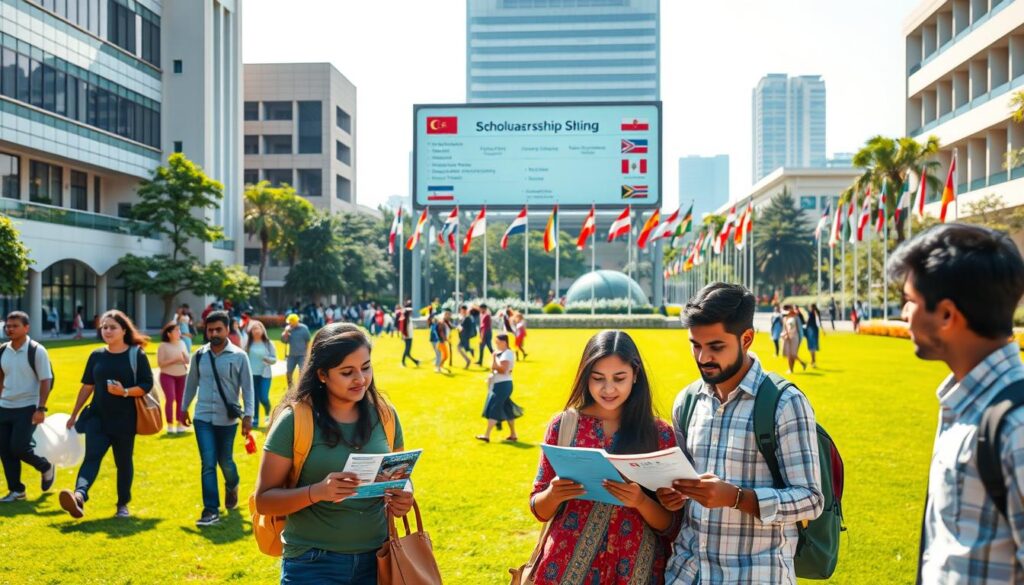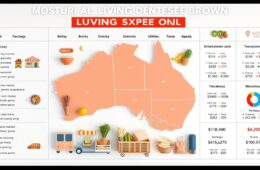
40 Scholarships to Study Abroad Across the Globe
Indian students now have over 40 scholarships to study abroad worldwide. This guide covers top programs like the Japanese Government Scholarship and Australia Awards. It helps you find international degree options without financial worries.
Study abroad scholarships can change your academic journey. They cover tuition, travel, and living costs in places like Canada, the U.S., and Europe.
Key Takeaways
- Discover 40 verified scholarships for study abroad around the world tailored for Indian applicants.
- Learn about merit-based, need-based, and field-specific study abroad scholarships.
- Understand how to build a strong application strategy for global scholarships.
- Explore eligibility criteria and application steps for programs like the Fulbright Foreign Student Program.
- Access tips for managing finances and avoiding common application mistakes.
Understanding the Global Scholarship Landscape
For Indian students dreaming of studying abroad, international scholarships are key. They help overcome the high costs of tuition and living. Scholarships make it possible for talented students to pursue their dreams without financial worries.
Why Scholarships Are Essential for International Education
Scholarships open doors to education across borders for students who can’t afford it. They cover everything from tuition to living expenses. This makes studying abroad a reality for many.
Types of Study Abroad Funding Opportunities
- Full scholarships: Cover tuition, accommodation, and sometimes stipends.
- Partial scholarships: Reduce costs by 30–70%, depending on merit or need.
- Travel grants: Support visa, flight, or research-related expenses.
- Cultural exchange programs: Combine funding with community engagement requirements.
How to Navigate the International Scholarship Ecosystem
Begin by looking into government programs like the U.S. Fulbright or UK Chevening. Universities also list scholarship opportunities on their websites. Keep track of deadlines and what you need to qualify.
Networking with alumni or attending education fairs can uncover more chances. Make sure your applications match your academic goals and strengths.
Preparing Your Scholarship Application Strategy
Getting study abroad funding begins with a solid plan. Start looking 12-18 months before you plan to go. Make a calendar for scholarship deadlines and when to submit documents. Financial aid for studying abroad is tough—stay organized to avoid missing anything.
- Timeline: Use Google Calendar or Trello to keep track of deadlines.
- Document Checklist: Have your transcripts, letters of recommendation, and a strong statement of purpose ready.
- Application Templates: Create drafts for essays and customize them for each scholarship.
“A well-organized application strategy turns scattered efforts into a winning portfolio,” says a former scholarship recipient who secured funding for Oxford.
Focus on scholarships with earlier deadlines and better fits for you. Mark down those needing research proposals first, as they’re often stricter. Use spreadsheets to compare what each scholarship requires. Highlight the ones that match your academic background and interests.
- Pro Tip: Prepare a “master resume” with your achievements, internships, and language skills. Adjust it for each application.
- Double-check visa and bank statement requirements for financial aid for studying abroad.
Remember, scholarships are a process, not a one-time thing. Use feedback from rejections to improve. Early planning and smart organization boost your chances of getting the right study abroad funding for your dreams.
North American Study Abroad Scholarships
North America has study abroad scholarships and overseas study grants for Indian students. These programs help with tuition, living costs, and professional growth. Here are some top opportunities:
Fulbright Foreign Student Program
U.S.-based grants for Indian graduates. They can pursue master’s or PhD degrees. Benefits include full tuition, J-1 visa fees, and monthly stipends.
- Eligibility: Indian citizens with strong academic records
- Deadline: October 15 (annual cycle)
- Award: Full funding for 1-2 years of study
Hubert Humphrey Fellowship Program
A year-long non-degree program for mid-career professionals. It focuses on public policy, health, and environmental studies at U.S. universities.
- Includes travel, health insurance, and research grants
- Eligibility: 3+ years work experience in public service
- Deadline: April 15
Canadian Excellence Scholarships
Canadian institutions offer overseas study grants for tuition and living costs. The Vanier CGS awards CAD$55k annually for PhD candidates.
- Eligibility: Open to international applicants at Canadian universities
- Check university websites for specific deadlines
- Fields: STEM, humanities, and social sciences
Mexico Government Scholarships
Mexico’s CONACyT grants fund Indian students’s master’s or doctoral studies. They cover tuition, housing, and a monthly allowance in engineering, agriculture, or public policy.
- Includes tuition, housing, and monthly allowance
- Deadline: February 1-28 annually
- Apply via Mexico’s National Scholarship Portal
Applications need strong academic records and clear career goals. Start early to gather recommendation letters and transcripts. Official program websites have detailed instructions.
European Academic Grants and Opportunities
Europe has academic grants abroad and international scholarships for top universities in 30+ countries. The Erasmus Mundus Joint Master Degrees and Marie Skłodowska-Curie Actions offer full funding for master’s and PhD studies. Indian students can find specific options for each country:
- Germany: DAAD scholarships cover tuition and living costs for all academic levels.
- France: France Excellence Scholarships waive fees for high-achieving students.
- Netherlands: Nuffic Neso scholarships support master’s degrees in STEM fields.
- Scandinavian countries: Norway, Sweden, and Denmark offer tuition-free education for most programs.
| Scholarship | Country | Key Benefit |
|---|---|---|
| Erasmus Mundus | EU-wide | Full funding + cross-border mobility |
| Marie Skłodowska-Curie | EU | Research grants + networking |
| UK Chevening | United Kingdom | Leadership training included |
Many international scholarships need proof of language skills (like IELTS/TOEFL). Countries like Germany and France look for strong academic records. Most EU programs open applications between October and January.
Eastern Europe is known for affordable living and rising university rankings. Countries like Poland and Hungary offer academic grants abroad with less competition than Western Europe. Start looking early—success rates range from 15% to 40% depending on the program.
40 Scholarships for Study Abroad Around the World: Comprehensive List
Indian students looking to study abroad have 40 scholarships to choose from. These global study awards help students pay for their education. They also support students’ cultural and financial goals.
“The Chevening Scholarship transformed my journey. It’s proof that dedication meets opportunity.” – Priya Mehta, Chevening Scholar 2023
Merit-Based International Scholarships
Top programs reward academic brilliance:
- Rhodes Scholarship: Covers Oxford degrees for visionary leaders. Apply by November 1.
- Gates Cambridge: Fully funds UK PhDs in any field for high-impact candidates.
Need-Based Global Study Awards
Financial barriers dissolve with support like:
- UNESCO Fellowships: Prioritizes underrepresented groups in STEM and social sciences.
- India-Australia Leadership Awards: Offers full tuition for eligible Indian nationals.
Field-Specific Overseas Study Grants
Targeted funding for specialized fields:
- IBM PhD Fellowship: Focuses on computer science and AI research.
- Wellcome Trust: Supports biomedical and health sciences research globally.
Cultural Exchange Scholarship Programs
Bridging borders through learning:
- Rotary Peace Fellows: Combines degree study with conflict resolution training.
- U.S. Fulbright Program: Open to master’s and PhD candidates promoting cross-cultural dialogue.
Asian and Pacific Scholarship Programs for Indian Students
Indian students looking into international scholarships in the Asia-Pacific find many scholarship opportunities. These programs help students reach their academic and career goals. They also bridge cultural and geographical gaps, offering high-quality education.

Japanese Government (MEXT) Scholarship
MEXT offers fully funded degrees for undergrad and grad studies. You need to pass Japanese language exams (N1 level) and submit a research proposal. Over 500 scholarships are given each year, covering tuition, living costs, and travel.
Australia Awards Scholarships
Australia’s main program focuses on STEM, agriculture, and public health. Winners get to join a global alumni network after graduation.
“Australia’s scholarships build leaders for Asia-Pacific development,” says the Department of Education.
Applications must be in on time, matching the academic cycle.
Singapore International Graduate Award (SINGA)
SINGA supports PhD students in engineering, data science, and sustainability. It covers fees, a monthly stipend, and healthcare. Singapore’s research scene is lively, with chances to work in A*STAR labs.
China Government Scholarship Program
China’s program is part of the Belt and Road initiative, focusing on infrastructure, tech, and language. It offers full tuition, accommodation, and travel grants. Top universities like Peking and Tsinghua have special programs for South Asian students.
Each program includes cultural training and support for living costs. Start early—applications open 6-8 months before deadlines. Check out these scholarship opportunities to get into top Asian-Pacific universities.
Scholarships for Studying in the Middle East and Africa
Indian students often miss out on study abroad scholarships in the Middle East and Africa. These areas have overseas study grants in fields like petroleum engineering and sustainable development. For example, Qatar Foundation scholarships focus on renewable energy, while the UAE supports tech and infrastructure projects.
- Qatar Foundation Scholarships: Support STEM research with a focus on desert agriculture and solar energy
- Saudi Arabia’s King Abdullah Program: Offers Islamic finance and cultural studies grants
- UCT Scholarships: University of Cape Town grants for environmental science and public health
- African Excellence Awards: Prioritize candidates studying biodiversity and climate resilience
To apply for these overseas study grants, you need good grades and to match regional goals. Knowing Arabic can help with Gulf scholarships, and French is useful for North Africa. Most applications open in early January. Make sure your field of study fits India’s needs, like petroleum engineering.
Studying in these areas opens doors to booming economies and cultural experiences. Over 30% of Gulf-based Indian professionals work in fields supported by these scholarships. Choose programs that align with your career goals and use India’s trade partnerships to strengthen your application.
Maximizing Your Eligibility for Global Study Opportunities
Getting study abroad funding or international scholarships is not just about good grades. Start early to make your profile stand out in competitive programs.
Academic Requirements for Top Scholarships
Top scholarships need a minimum GPA of 3.0 (or equivalent). Indian students should know how their grades compare to international standards. Most programs require GRE/GMAT scores for graduate school and English tests like TOEFL or IELTS. Always check the specific requirements for each scholarship.
Building a Compelling Profile Beyond Grades
Admissions committees want to see your passion and drive. Make sure to highlight these in your application:
- Research projects or publications in your field
- Leadership roles in clubs or community work
- Professional internships or volunteer experience
- International exposure through exchange programs or conferences
“A standout application balances grades with real-world impact,” says Dr. Priya Mehta, scholarship advisor at IIEC. “Show how your experiences prepare you to thrive abroad.”
Language Proficiency Considerations
Being proficient in English is key for most international scholarships. Aim for TOEFL scores above 90 or IELTS 6.5. Use official prep materials and mock tests to practice. Learning a second language like German or Mandarin can also help for scholarships in those regions.
Crafting Winning Scholarship Applications

Start by telling your story clearly. For scholarship opportunities, your statement of purpose should have three parts. These are your academic goals, how the program fits your career, and your community impact. Don’t just focus on grades; share your unique experiences too.
“My essay about rural education work made my application memorable,” said Priya Mehta, a 2023 Chevening scholar. “I linked my fieldwork to the university’s research focus.”
Here are steps to boost your financial aid for studying abroad chances:
- Use active verbs: “I led a project” vs. “I was part of a group.”
- Ask mentors who know your work ethic, not just titles, for recommendations.
- Practice mock interviews in English to tackle cultural communication gaps.
Research proposals should highlight knowledge gaps in your field. For example:
| Aspect | Action Steps |
|---|---|
| Problem Statement | Use recent studies from the host country’s journals |
| Methodology | Align with the university’s lab facilities |
| Budget | Show cost estimates for equipment and travel |
Check your statements with this list: Does it explain why this scholarship, why this university, and why now? Tailoring answers boosts your chances. Every detail matters in standing out globally.
Financial Planning Beyond Scholarships for Studying Abroad
Getting scholarships is just the start. Smart planning keeps your study abroad trip worry-free. Here’s how to manage costs beyond study abroad funding:
Part-Time Work Opportunities
Many places let international students work up to 20 hours a week. In the US, jobs at libraries or labs are common. Germany offers work in dining halls or IT support. Always check visa rules before taking a job.
Part-time jobs help with daily costs like food or transport.
Currency & Banking Tips
Open a local bank account early to avoid high fees. Use apps like Wise or Revolut to track exchange rates. A student in the UK might save 15% on currency conversion with these tools.
Keep 10% of your money as emergency cash for visa fees or sudden travel.
Budgeting Basics
- Essentials: Rent, food, and transport take 60% of expenses
- Hidden costs: Winter coats in Canada, visa renewal fees, or flight home twice a year
- Savings goal: Aim for ₹50,000–₹1,00,000 buffer for unexpected costs
“My budget spreadsheet tracked every coffee purchase—it kept me from overdrawing my account,” shared Anika, a student in Sweden.
Use financial aid for studying abroad with these tips to stay financially stable. Start tracking expenses today with free apps like Mint or Money Manager.
Common Mistakes to Avoid in International Scholarship Applications
Indian students applying for international scholarships often miss simple steps. They might miss deadlines, write generic essays, or ignore program rules. Let’s look at common mistakes and how to avoid them:
“A well-prepared application shows you’re ready to seize scholarship opportunities—don’t let small mistakes hold you back.”
| Mistake | Solution |
|---|---|
| Ignoring deadlines | Mark deadlines in a calendar; set reminders 2 weeks before. |
| Generic personal statements | Customize essays to align with the scholarship’s mission. Highlight how you’ll contribute to its goals. |
| Wrong document formats | Check if documents need notarization, PDF formats, or specific naming conventions. |
Cultural differences are important too. In some places, being modest in essays might seem weak. Learn to balance humility with confidence. Also, research how to address professors or structure interviews in the host country.
Pro tip: Start early! Give yourself time to revise and get feedback. Many international scholarships reject incomplete or mismatched documents. Explore all scholarship opportunities, but apply wisely—quality over quantity.
Conclusion: Turning Your Study Abroad Dreams into Reality
Choosing the right scholarship is the first step to achieving your dreams. Students like Anika and Raj show that hard work pays off. They won scholarships by improving their proposals and focusing on community impact.
Start by looking at the 40 scholarships for study abroad around the world in this guide. Match your skills with opportunities like Canada’s Excellence Scholarships or Australia Awards.
Plan your journey by mapping a timeline. Research scholarships three years before you want to start. Tailor applications two years ahead, and finalize choices one year before you enroll.
Common mistakes like last-minute applications can be avoided. Use strategies from earlier sections to improve. Platforms like the U.S. Department of State’s EducationUSA or DAAD (Germany) offer free counseling to help you.
Remember, scholarships like China’s Government Scholarship value clarity and passion over perfection. Use tools like ScholarshipPortal.in to track deadlines. Network with alumni from institutions like IITs or NITs who have succeeded abroad.
Every step, from improving language scores to drafting a personal statement, brings you closer to your goal. Keep working towards turning your vision into reality.


